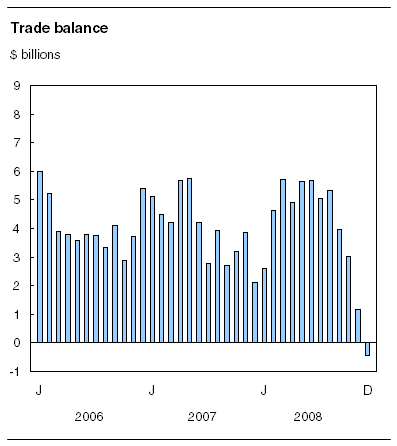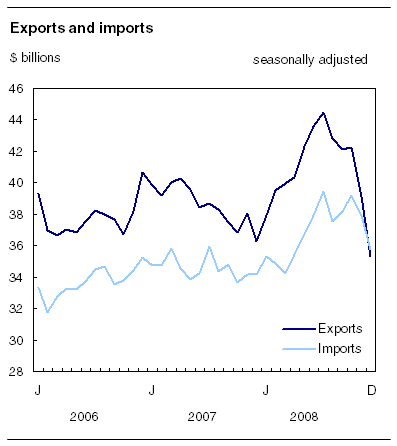Common menu bar links
Canadian international merchandise trade
Archived Content
Information identified as archived is provided for reference, research or recordkeeping purposes. It is not subject to the Government of Canada Web Standards and has not been altered or updated since it was archived. Please "contact us" to request a format other than those available.
Exports and imports dropped in December amid a global economic downturn with exports falling at a faster pace than imports. This resulted in a trade deficit of $458 million compared with a trade surplus of $1.2 billion in November. This was the first trade deficit since March 1976.
Chart 1

Exports dropped 9.7% to $35.3 billion, as both prices and volumes declined. This marked the largest month-over-month percentage decrease since October 1982. The declines were widespread across most sectors. Overall, exports have been trending downwards since July 2008.
Imports also declined, falling 5.7% to $35.8 billion. The decrease, reflecting mostly volume reductions, was largely attributable to machinery and equipment, automotive products, and industrial goods and materials.
Although exports and imports have been declining in recent months, trade in agricultural and fishing products as well as machinery and equipment has generally been on the rise throughout 2008.
Exports to the United States dropped 10.0% to $25.9 billion. The slump in exports, led by crude petroleum, outpaced an 8.4% fall in imports. As a result, Canada's trade balance with the United States fell from $4.6 billion in November to $3.8 billion in December, its lowest level since December 1998.
Note to readers
Merchandise trade is one component of the current account of Canada's balance of payments, which also includes trade in services, investment income and transfers.
International merchandise trade data by country are available on both a balance of payments and a customs basis for the United States, Japan and the United Kingdom. Trade data for all other individual countries are available on a customs basis only. Balance of payments data are derived from customs data by making adjustments for characteristics such as valuation, coverage, timing and residency. These adjustments are made to conform to the concepts and definitions of the Canadian System of National Accounts.
Constant dollars referred to in the text are calculated using the Laspeyres volume formula, which is current dollars divided by Paasche indexes.
Revisions
In general, merchandise trade data are revised on an ongoing basis for each month of the current year. Current year revisions are reflected in both the customs and balance of payments based data. Revisions to customs based data for the previous year are released on a quarterly basis. Annual revisions to 2005, 2006 and 2007 data, on a customs basis, are released today.
Factors influencing revisions include late receipt of import and export documentation, incorrect information on customs forms, replacement of estimates with actual figures, changes in classification of merchandise based on more current information, and changes to seasonal adjustment factors.
Revised data are available in the appropriate CANSIM tables.
Canada's trade deficit with countries other than the United States grew to $4.2 billion in December from $3.4 billion in November, as exports declined 9.0% while imports fell 1.0%.
Energy products and industrial goods continue to lead the downturn in exports
Exports of energy products dropped 19.4% to $6.8 billion. This reflected slumping exports of crude petroleum which continued to decline, falling a further 29.1% to $2.8 billion, the lowest level since March 2006. The decrease in crude petroleum was mostly the result of a 25.0% drop in prices.
Exports of industrial goods and materials fell 17.1% to $7.4 billion, largely due to a drop in volume. The sector has been on a downward trend since July 2008. Fertilizer exports dropped 36.8%, erasing two consecutive months of increases. In addition, exports of aluminium (including alloys) decreased 26.7% in December, as demand from the automotive sector waned with cutbacks in production.
Agricultural and fishing products exports dropped 7.0% to $3.4 billion in December. The sector had been trending upward since June 2006. Decreases in exports of wheat, meat and meat preparations, and canola mostly accounted for the sector's decline following two monthly gains.
Chart 2

Broad-based contraction in imports
After three consecutive monthly increases, imports of machinery and equipment fell 5.7% to $10.6 billion, leading the decline in imports for December. This decrease was due to a combination of rising prices and falling volumes. Aircraft imports rose 26.7%, softening the sector's overall drop.
Imports of automotive products declined for the third consecutive month, dropping 9.8% to $5.2 billion as the industry continued to struggle with decreased sales. The latest decline is the result of a 10.6% fall in volume overshadowing a small rise in price. The main contributor was motor vehicle parts, which lost 17.0% as manufacturers continued to scale back production. Imports of passenger autos, on a downward trend since July, fell 6.8% to $1.8 billion.
Imports of industrial goods and materials fell 5.8% to $7.4 billion. This was the lowest level since April 2008, reflecting the decline in both price and volume. Leading the decrease was imports of chemicals and plastics, which dropped 11.9% as a result of lower motor vehicle production and construction activity. Mitigating the drop, iron and steel products rose 19.8%, largely due to increased imports of drilling pipes.
Available on CANSIM: tables 228-0001 to 228-0003, 228-0033, 228-0034, 228-0041 to 228-0043 and 228-0047 to 228-0057.
Definitions, data sources and methods: survey numbers, including related surveys, 2201, 2202 and 2203.
The December 2008 issue of Canadian International Merchandise Trade, Vol. 62, no. 12 (65-001-XWE, free) is now available from the Publications module of our website.
The publication includes tables by commodity and country on a customs basis. The publication format has changed from a bilingual format to separate English and French versions to comply with Treasury Board Common Look and Feel's Guidelines. Table numbers have been modified, for a concordance from the old to the new tables.
Current account data (which incorporate merchandise trade statistics, service transactions, investment income and transfers) are available quarterly in Canada's Balance of International Payments (67-001-XWE, free).
For more information, contact Sharon Nevins (toll-free 1-800-294-5583; 613-951-9798). To enquire about the concepts, methods or data quality of this release, contact Mychèle Gagnon (613-951-0994), International Trade Division.
Table 1
| November 2008r | December 2008 | November to December 2008 | December 2007 to December 2008 | |
|---|---|---|---|---|
| Seasonally adjusted, $ current | ||||
| $ millions | % change | |||
| Principal trading partners | ||||
| Exports | ||||
| United States | 28,808 | 25,935 | -10.0 | -7.6 |
| Japan | 1,143 | 991 | -13.3 | 27.5 |
| European Union1 | 3,085 | 3,651 | 18.3 | 25.1 |
| Other OECD countries2 | 2,046 | 1,268 | -38.0 | -7.8 |
| All other countries | 4,023 | 3,459 | -14.0 | 10.6 |
| Total | 39,104 | 35,304 | -9.7 | -2.7 |
| Imports | ||||
| United States | 24,205 | 22,169 | -8.4 | 1.7 |
| Japan | 1,092 | 783 | -28.3 | -23.7 |
| European Union1 | 3,713 | 4,091 | 10.2 | 21.6 |
| Other OECD countries2 | 2,484 | 2,324 | -6.4 | 7.5 |
| All other countries | 6,447 | 6,395 | -0.8 | 9.6 |
| Total | 37,942 | 35,762 | -5.7 | 4.6 |
| Balance | ||||
| United States | 4,603 | 3,766 | ... | ... |
| Japan | 51 | 208 | ... | ... |
| European Union1 | -628 | -440 | ... | ... |
| Other OECD countries2 | -438 | -1,056 | ... | ... |
| All other countries | -2,424 | -2,936 | ... | ... |
| Total | 1,162 | -458 | ... | ... |
| Principal commodity groupings | ||||
| Exports | ||||
| Agricultural and fishing products | 3,663 | 3,405 | -7.0 | 18.8 |
| Energy products | 8,434 | 6,799 | -19.4 | -15.9 |
| Forestry products | 2,151 | 2,051 | -4.6 | -3.2 |
| Industrial goods and materials | 8,904 | 7,384 | -17.1 | -7.0 |
| Machinery and equipment | 8,377 | 8,207 | -2.0 | 15.3 |
| Automotive products | 4,855 | 4,695 | -3.3 | -16.9 |
| Other consumer goods | 1,456 | 1,635 | 12.3 | 14.9 |
| Special transactions trade3 | 724 | 674 | -6.9 | 4.7 |
| Other balance of payments adjustments | 540 | 454 | -15.9 | 8.4 |
| Imports | ||||
| Agricultural and fishing products | 2,563 | 2,537 | -1.0 | 17.3 |
| Energy products | 3,663 | 3,283 | -10.4 | -6.9 |
| Forestry products | 246 | 214 | -13.0 | -13.4 |
| Industrial goods and materials | 7,891 | 7,435 | -5.8 | 5.9 |
| Machinery and equipment | 11,277 | 10,636 | -5.7 | 11.0 |
| Automotive products | 5,806 | 5,238 | -9.8 | -12.0 |
| Other consumer goods | 5,260 | 5,182 | -1.5 | 14.2 |
| Special transactions trade3 | 477 | 540 | 13.2 | 25.9 |
| Other balance of payments adjustments | 759 | 698 | -8.0 | -2.4 |

